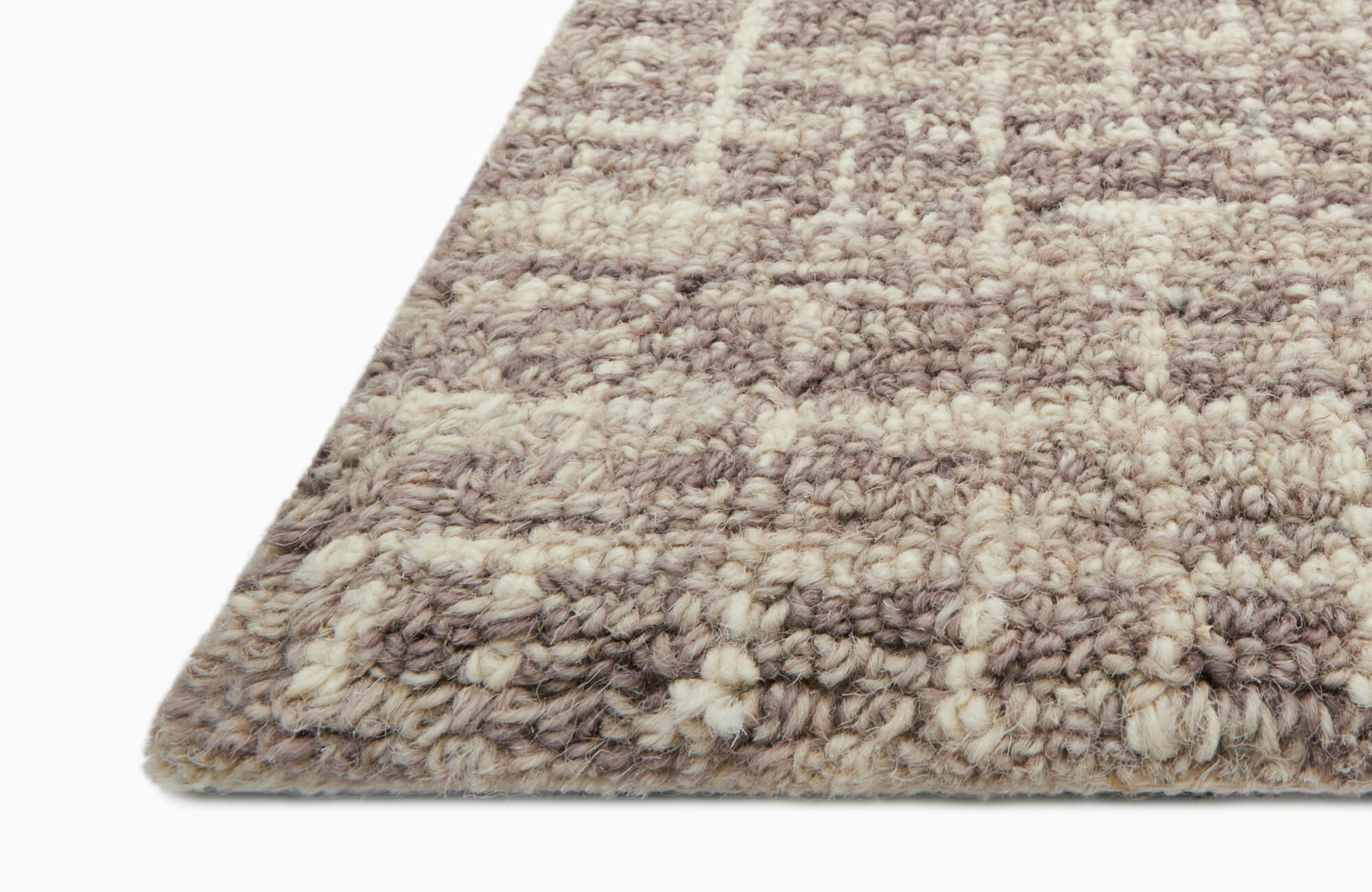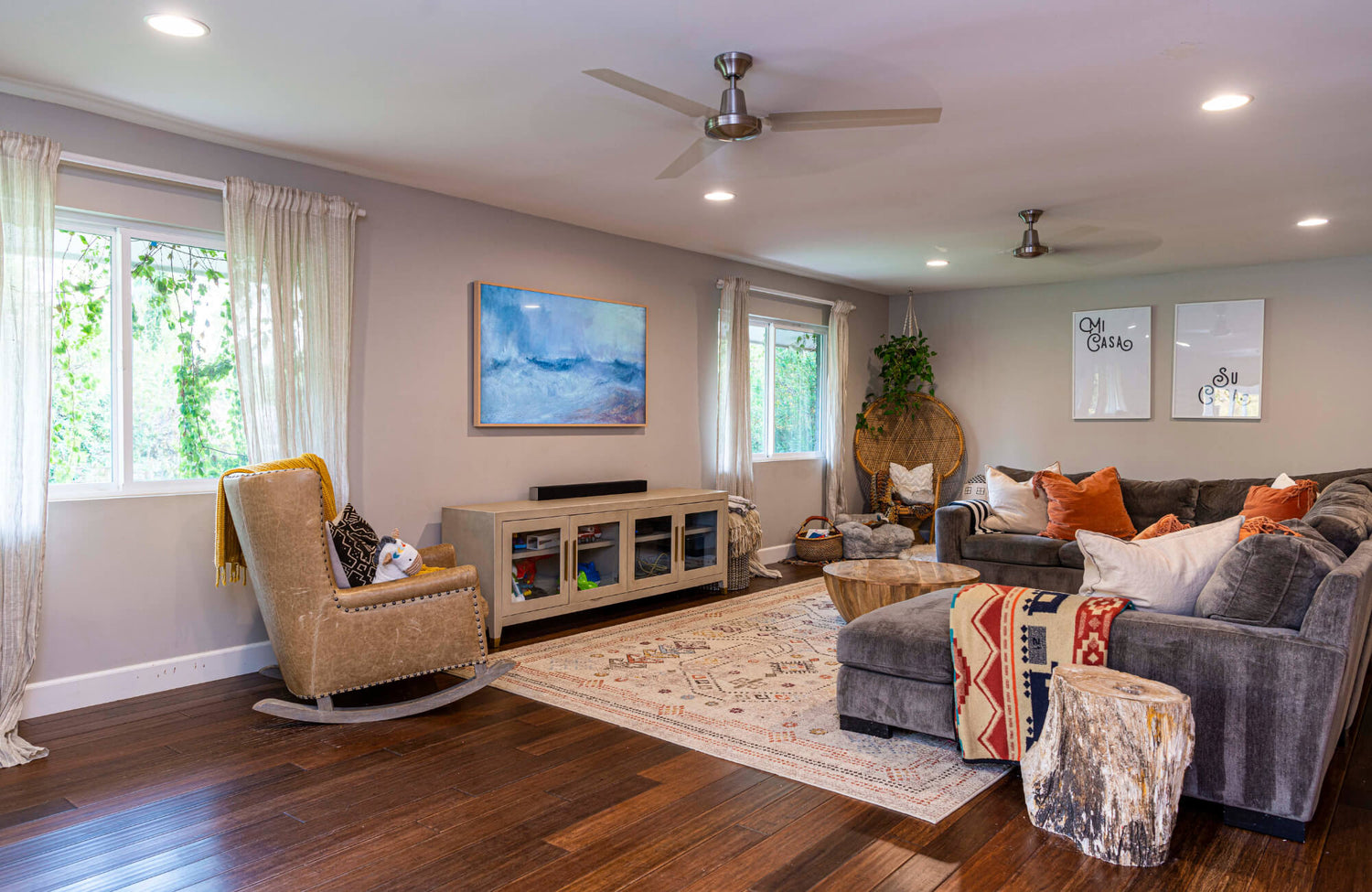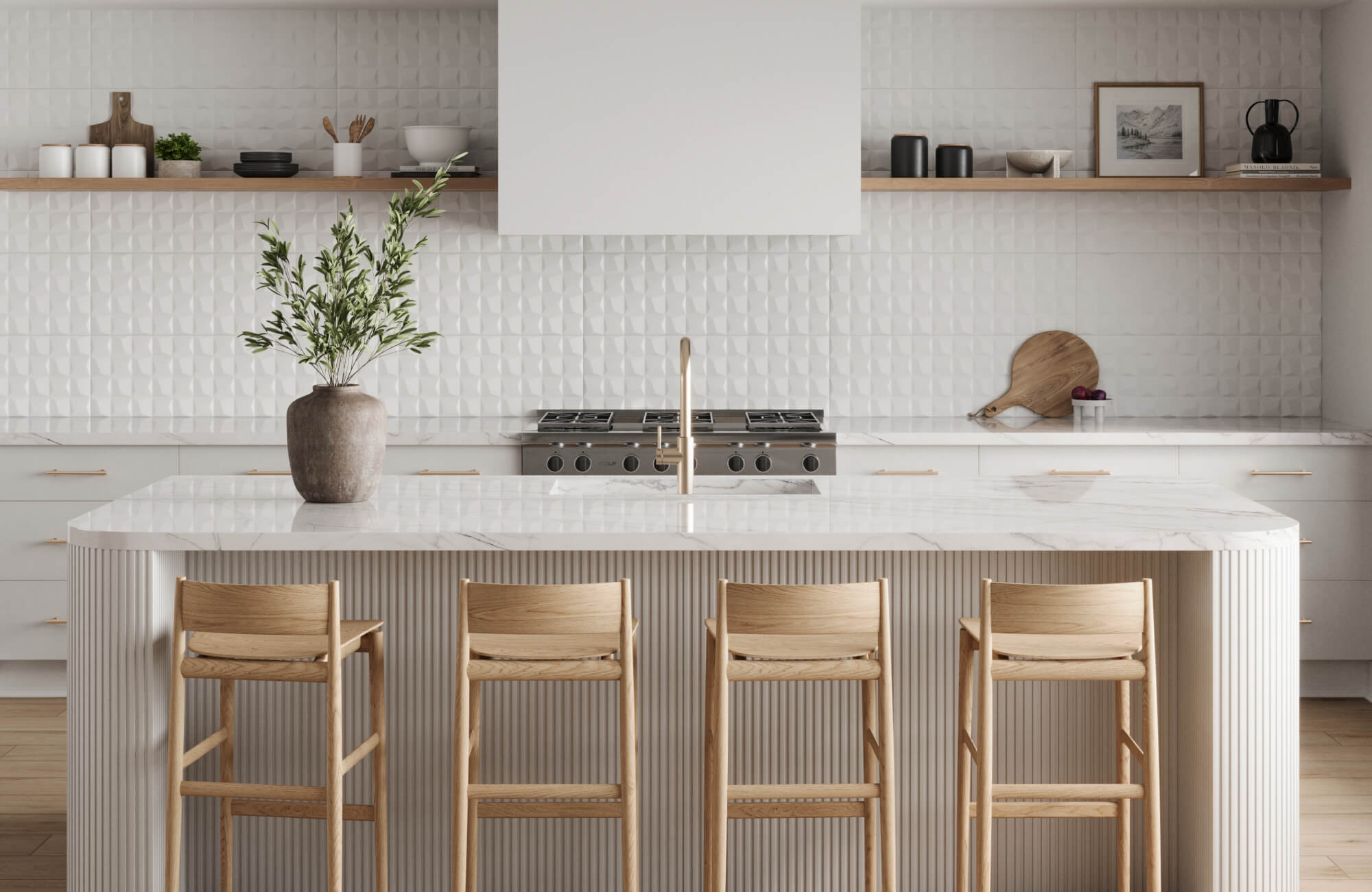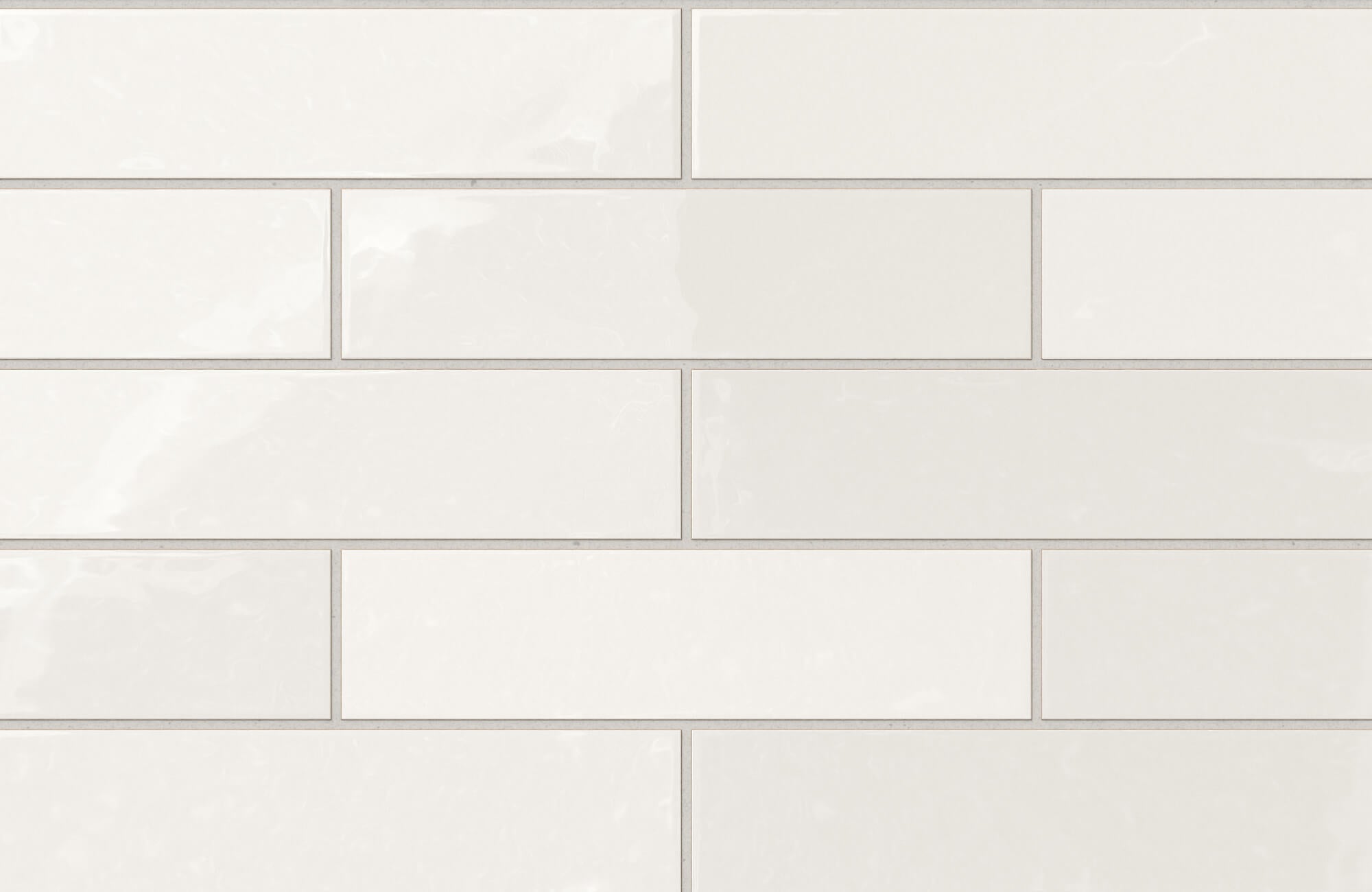Wool rugs are often misunderstood in allergy-conscious design. While some assume natural fibers attract allergens, properly sourced and maintained wool can actually promote a cleaner indoor environment. Thanks to its unique structure, wool captures airborne particles while resisting moisture, bacteria, and static, conditions that typically trigger allergic responses.
From a materials standpoint, wool is a protein-rich fiber that naturally resists common indoor irritants like mold, dust mites, and VOCs. With that in mind, this blog explores how wool rugs perform in allergen-sensitive homes, highlighting their benefits and outlining key considerations for making an informed flooring choice.

Common Household Allergens in Rugs
To make an informed rug choice, especially for allergy-sensitive spaces, it’s important to first understand how common household allergens behave in and around textiles. From invisible dust mites to lingering pet dander and moisture-loving mold spores, each poses a unique challenge that rugs can either help manage or unintentionally worsen.
Dust Mites and Their Habitat
Fundamentally, dust mites thrive in warm, humid environments and feed on shed human skin cells. Rugs with dense pile or moisture-retentive fibers can create ideal breeding grounds for these microscopic pests. However, the real concern for allergy sufferers lies not in the mites themselves, but in their microscopic waste and body fragments, which easily become airborne through wear patterns or vacuuming.
To help combat this, maintaining indoor humidity below 45% and vacuuming regularly with a HEPA-filter vacuum can significantly reduce infestations. Additionally, steam cleaning above 130°F is an effective way to neutralize mites without harming wool fibers. Selecting rugs with low pile and tight weaves further minimizes dust mite penetration, making them easier to clean and less accommodating to allergens.
Pet Dander Accumulation
In addition to dust mites, pet dander poses a persistent allergenic challenge. These microscopic skin flakes contain potent proteins and readily adhere to rug fibers, lingering in indoor air. Wool may reduce airborne spread due to its lower static charge, yet dander can still accumulate without consistent care.
To mitigate buildup, vacuuming at least twice weekly with a sealed-system HEPA vacuum is recommended. Furthermore, deep-cleaning with enzyme-based products helps break down allergenic proteins more effectively than standard detergents. For even greater control, consider removable and washable rug options, such as flat-weave or modular tile styles.
Mold Spores and Moisture Trapping
Finally, mold spores are a major concern in damp or poorly ventilated areas, such as basements, bathrooms, and entryways. Wool's hygroscopic nature allows it to absorb and release moisture, which can help regulate indoor humidity. However, if not properly maintained, this same property can increase the risk of mold growth.
To prevent mold from taking hold, proactive steps are essential. Using dehumidifiers, promoting airflow beneath rugs, and promptly drying spills can greatly reduce the risk of fungal colonization. Additionally, antimicrobial rug pads and breathable backing materials offer added defense. If mold contamination does occur, professional cleaning with appropriate methods can resolve the issue without compromising the rug’s integrity.

Wool's Unique Fiber Structure and Allergen Retention
To understand why wool performs so well in allergy-conscious spaces, it helps to look closely at what makes the fiber unique, both in composition and construction. From the way it naturally resists microbes to how it holds or releases particles, wool’s structure is fundamental to its allergen-related performance.
Natural Hypoallergenic Properties of Lanolin
Notably, lanolin, a natural wax secreted by sheep, coats wool fibers and functions as a built-in antimicrobial and dust-repellent barrier. While sometimes misidentified as an allergen, true lanolin sensitivity is rare and typically associated with concentrated cosmetic forms, not the trace levels found in finished textiles. In wool rugs, lanolin helps prevent the growth of bacteria, mold, and fungi, contributing to a cleaner surface overall.
Moreover, wool’s hydrophobic exterior resists surface moisture, while its inner cortex-cuticle system absorbs and releases vapor. This ability to buffer indoor humidity discourages environments where allergens thrive. One clear example of this performance is Edward Martin’s Mallory Wool Pile Rug in Khaki, which blends dense construction with lanolin-rich fibers to enhance allergen control in stylish, wellness-focused spaces.
Tightly Woven Fibers Versus Loose Pile
Building on that foundation, the physical construction of a wool rug, particularly its density and weave, significantly affects how allergens are retained or released. Tightly woven, low-pile rugs like flat-weave or looped styles leave fewer spaces for dust and dander to settle, making them easier to clean and more hygienic for allergy-sensitive homes.
In contrast, high-pile or loosely constructed rugs create deeper recesses that trap allergens and complicate maintenance. Additionally, wool’s natural crimped structure enhances its resilience, helping the rug maintain shape and reduce compaction over time, an added benefit for minimizing allergen buildup between cleanings.
Shedding and Fiber Fragments
Finally, it’s important to consider shedding. During the first months of use, especially with hand-tufted or machine-made wool rugs, some fiber shedding is normal. While wool itself is non-allergenic, loose fibers can carry household dust and irritants, which may affect indoor air quality if unmanaged.
To minimize these effects, regular vacuuming with a HEPA-filter unit is essential. This not only removes fiber fragments but also captures any attached particulates. Fortunately, shedding typically subsides as the rug stabilizes. Investing in well-made, high-quality rugs can further reduce both the duration and intensity of this phase.

Addressing Common Misconceptions About Wool and Allergies
Despite its many benefits, wool is often subject to confusion when it comes to allergies, largely due to myths that don’t hold up under closer scrutiny. To set the record straight, it's worth examining what wool is (and isn’t), how it stacks up against synthetic alternatives, and the surprising ways it can actually help reduce airborne allergens.
Is Wool Itself an Allergen?
As a starting point, it’s worth addressing one of the most widespread misconceptions: that wool is inherently allergenic. In reality, wool does not contain the proteins responsible for common pet allergic reactions, such as Fel d 1 from cats, Can f 1 from dogs, or Der p 1 from dust mites. Instead, reports of discomfort are usually due to mechanical irritation from coarse, low-grade fibers, not a true allergic response. In fact, fine-grade wools like Merino, with fibers under 20 microns, are widely used in medical and infant products precisely because of their skin-friendly properties.
Furthermore, when allergy-like symptoms appear around wool rugs, the actual triggers are more often environmental, such as dust, mold, or chemical residues, rather than the wool itself. Certified wool products (e.g., OEKO-TEX, Woolmark) are manufactured without harsh additives and emit negligible levels of VOCs, making them a safer choice for chemically sensitive individuals.
Wool Versus Synthetic Fibers for Allergies
In comparison to wool, synthetic fibers like nylon, polypropylene, and polyester present additional concerns for allergy sufferers. These materials are more prone to static electricity, which attracts and suspends particles such as dust and pet dander, allowing allergens to circulate longer or become embedded within the rug.
By contrast, wool’s natural antistatic properties and scaly, hydrophilic surface help it trap allergens until removed by vacuuming. Just as importantly, wool generally requires fewer chemical treatments, avoiding flame retardants, stain guards, and adhesives often used in synthetic rugs that can off-gas VOCs. This makes wool a more allergy-friendly material in both construction and performance.
For example, Edward Martin’s Mallory Wool Pile Rug in Primrose illustrates this advantage well. Designed with indoor air quality in mind, it balances comfort and health-conscious materials, offering a thoughtful alternative to chemically treated synthetics.
The Allergen Trap Benefit of Rugs
Finally, it’s important to understand that rugs, when well-maintained, can contribute meaningfully to allergen control. Rather than releasing allergens into the air, certain rug materials and structures, particularly wool, can act as passive traps, capturing particulates and keeping them out of the breathing zone.
This is due in part to wool’s unique fiber morphology. Its outer cuticle, composed of overlapping scales, functions like roof shingles, physically locking in pollen, soot, and microbial debris. Unlike the smooth surfaces of synthetic fibers, which may release allergens with minimal movement, wool holds them in place until vacuumed. When used in tandem with broader allergy strategies, such as HEPA filtration and humidity control, wool rugs can meaningfully contribute to a cleaner, healthier indoor environment.

Crucial Factors for Allergy Sufferers Choosing Wool Rugs
Choosing a wool rug for an allergy-conscious home goes beyond the fiber itself; it’s also about how the rug is made, treated, and assembled. From chemical finishes to construction details, several behind-the-scenes factors can make a big difference in how a rug performs in sensitive environments.
Choosing Low VOC and Natural Dye Options
Initially, while wool is naturally low in emissions, the finishing treatments and dyes used in its production can introduce volatile organic compounds (VOCs), chemical compounds known to trigger respiratory symptoms and chemical sensitivities. Common culprits include synthetic dyes, mothproofing agents, and stain-resistant finishes.
To mitigate these risks, opt for wool rugs certified by third-party standards such as GREENGUARD Gold, OEKO-TEX, or GOTS. Additionally, rugs dyed with vegetable-based or mineral pigments tend to have lower emissions and are less irritating to sensitive individuals. These low-impact alternatives not only promote better indoor air quality but also contribute to a healthier and more sustainable living environment.
Pile Height and Density Considerations
Equally important is the rug’s physical structure. Pile height and fiber density directly influence how a rug retains or repels allergens. Low to medium pile rugs, particularly those under 0.5 inches, are less likely to trap dust, dander, and pollen, and are much easier to vacuum thoroughly. In contrast, high-pile options often harbor allergens deep within the fibers, increasing maintenance demands.
Dense constructions like flat-weave, loop-pile, or tightly tufted wool styles are especially effective in minimizing particle accumulation. One excellent example is Edward Martin’s Sweeney Wool Pile Rug in Mushroom above, which combines a tightly looped texture with hand-hooked detailing. The result is a surface that’s both plush and practical for allergy-prone spaces.
Backing Materials and Adhesives
Finally, it’s crucial not to overlook the materials used in the rug’s backing and any adhesives involved. Many mass-produced rugs feature synthetic latex or PVC backing, which can release VOCs over time, negatively affecting indoor air quality. For those with sensitivities, rugs backed with natural materials like jute, cotton, or natural rubber are a far better choice.
In addition, hand-knotted or hand-loomed rugs typically forgo chemical adhesives altogether, making them inherently safer. When a rug pad is necessary, opt for one made from untreated felt or natural rubber to provide floor protection and cushioning without adding unnecessary chemical exposure.

Effective Cleaning and Maintenance Strategies for Wool Rugs
Keeping wool rugs allergy-friendly doesn’t just happen on its own; it takes the right cleaning habits and a bit of routine care. From how often you vacuum to how you handle moisture, these daily and seasonal practices are essential to maintaining a healthier indoor environment.
Daily and Weekly Vacuuming Techniques
At the core of routine maintenance, regular vacuuming is essential for minimizing allergen buildup in wool rugs. It’s best to use a vacuum equipped with a high-efficiency particulate air (HEPA) filter, which can trap particles as small as 0.3 microns, including common allergens like dust mites, pollen, and pet dander. Moreover, sealed-system models are highly recommended to prevent allergens from escaping through exhaust vents.
When it comes to technique, avoid aggressive brush rolls that may damage wool fibers or increase shedding, especially in hand-tufted or hand-loomed varieties. Instead, use suction-only settings or soft-bristle attachments for loop or flat-weave styles. For cut pile rugs, a height-adjusted motorized brush may be used with care. Additionally, focus on busy zones and vacuum both sides periodically to remove embedded debris. As always, refer to the manufacturer’s care guidelines to ensure the correct method for your specific rug type.
Professional Cleaning Recommendations
In addition to regular vacuuming, professional cleaning is vital for deep allergen removal. Ideally, wool rugs should be serviced every 12 to 18 months, or more frequently in homes with pets, children, or excess humidity. Among the available methods, hot water extraction using pH-balanced, wool-safe detergents stands out as one of the most effective. This technique helps lift embedded particles while preserving the rug’s structural integrity and lanolin coating.
That said, selecting the right cleaning service is just as important. Professionals with experience in natural fibers should be prioritized to avoid risks like oversaturation, shrinkage, or dye bleeding. For delicate, antique, or moisture-sensitive rugs, dry compound cleaning may offer a safer alternative. Be sure to request non-toxic, fragrance-free cleaning agents to reduce chemical residues and protect indoor air quality.
Managing Moisture and Humidity
Finally, moisture management is vital to allergen prevention, particularly with wool, which is hygroscopic and capable of absorbing up to 30% of its weight in moisture without feeling damp. While this quality helps regulate indoor humidity, it also increases the risk of mold or mildew if not managed properly.
To prevent moisture-related issues, maintain indoor relative humidity between 35% and 50% using dehumidifiers and good ventilation, especially in high-moisture areas like basements, bathrooms, or kitchens. In the event of spills, blot immediately with clean, absorbent cloths; never rub, as this can push moisture deeper into the pile. For spot cleaning, choose low-moisture solutions specifically formulated for wool. And if a rug becomes saturated, ensure it is dried thoroughly with proper airflow, preferably elevated off the ground. Lastly, avoid placing rugs over impermeable surfaces or foam pads that could trap moisture and promote microbial growth.

Placement Considerations for Allergy Sufferers
Where you place a wool rug can be just as important as the rug itself, especially when managing allergies. Depending on the room, foot movement, and flooring type, thoughtful placement can either support a cleaner indoor space or unintentionally introduce challenges.
Avoiding Bedrooms for Severe Sufferers
From the outset, bedrooms are particularly sensitive zones for allergy sufferers due to the amount of time spent there during sleep. Even tightly woven, low-pile wool rugs can retain microscopic particulates like dust mites and pet dander, which may trigger symptoms if not thoroughly and consistently cleaned.
Therefore, for individuals with moderate to severe sensitivities, it may be advisable to avoid placing rugs in sleeping areas altogether. Alternatively, small, washable wool rugs positioned away from high-contact zones, such as at the foot of the bed rather than alongside it, can offer comfort with reduced allergen risk. When rugs are used in bedrooms, pairing them with hypoallergenic bedding and a HEPA-certified air purifier can further minimize exposure to irritants.
Busy Versus Non-Busy Areas
Moving into shared or frequently used spaces, usage levels significantly influence how rugs interact with allergens. In busy areas, such as living rooms, entryways, and hallways, dense, low-pile wool rugs are ideal. These styles act as passive filters, capturing airborne particles and helping reduce circulation throughout the room, assuming they are cleaned on a regular schedule.
On the other hand, low-use areas like guest rooms or home offices offer greater flexibility in rug texture and pile height. Even so, consistent maintenance remains essential to keep allergen accumulation at bay. A versatile solution for high-use zones is Edward Martin’s Sweeney Wool Pile Rug in Graphite above, which features a tightly looped construction and practical pile height, balancing durability, aesthetic appeal, and ease of upkeep.
Pairing with Hardwood or Tile Flooring
Lastly, the surface beneath the rug is central to effective allergen management. Hard flooring materials such as wood, tile, or natural stone are optimal companions for wool rugs. These non-porous surfaces don’t harbor dust mites or mold and are easy to clean, helping to localize and control allergens more effectively.
To further support air circulation and moisture regulation, pair wool rugs with breathable, non-slip rug pads made from natural materials like felt or untreated rubber. Conversely, avoid wall-to-wall carpet or foam padding, as these can trap moisture and impede airflow. Additionally, lifting rugs regularly and vacuuming underneath helps maintain a hygienic environment over time.
Moreover, for those coordinating rugs with tile or hardwood flooring, Edward Martin’s design consultation service offers one-on-one guidance from initial selection to final delivery. Whether you’re prioritizing allergen control or aiming to achieve a cohesive design aesthetic, our team ensures your choices align with both functional needs and style preferences.
In addition, if you have specific questions, need tailored recommendations, or want assistance narrowing down options, our Contact Us page is an excellent starting point. Our specialists are readily available to provide thoughtful, informed support and help you select the ideal rug for your home.

Holistic Allergy Management at Home
Even the most thoughtfully chosen rug can only do so much without a broader strategy to support it. That’s why creating an allergy-friendly home also means looking beyond the rug, addressing the air you breathe, the fabrics you live with, and how your space handles moisture and airflow.
Air Purification Systems
One of the most effective first measures, air purifiers equipped with true HEPA filters, are among the most effective tools for removing airborne allergens. These filters capture fine particles like pollen, pet dander, mold spores, and dust mite debris with exceptional precision. For best results, place HEPA units in heavily-used areas such as bedrooms, living rooms, and anywhere rugs or upholstered furniture are present.
In addition, advanced models may include activated carbon filters for absorbing VOCs and odors, or UV-C light for neutralizing airborne microbes. However, it’s important to steer clear of ozone-generating purifiers, as ozone can aggravate respiratory symptoms. For comprehensive coverage, whole-house filtration systems integrated into HVAC setups offer ongoing purification, especially beneficial in multi-story homes or for those managing chronic allergies.
To enhance these systems aesthetically and functionally, consider Edward Martin’s Mallory Wool Pile Rug in Aloe. Its breathable natural wool construction and botanical-inspired pattern complement HEPA filtration, contributing to a serene, health-conscious living space.
Regular Cleaning of Other Textiles
Moving beyond rugs, it’s crucial to address the many other textiles in your home that can act as allergen reservoirs. Drapery, bedding, and upholstered furniture absorb airborne particles through static and moisture, creating hidden hotspots for allergens if not cleaned regularly.
To counter this, wash bedding weekly in water heated above 130°F (54°C) to kill dust mites and denature allergenic proteins. Furthermore, use allergen-impermeable encasements for pillows and mattresses. Upholstered items should be vacuumed weekly with HEPA-filter tools and steam cleaned or professionally serviced at least twice a year. Where feasible, opt for washable curtains and removable slipcovers made from tightly woven fabrics to simplify cleaning and limit dust retention.
Humidity Control and Ventilation
Equally important is the regulation of indoor moisture and airflow. Maintaining relative humidity between 35% and 50% helps suppress mold growth and reduces dust mite populations. In moisture-prone areas like basements, bathrooms, or laundry rooms, dehumidifiers are essential. Conversely, humidifiers, when used in dry seasons, must be cleaned regularly to avoid microbial contamination.
Moreover, proper ventilation is essential for maintaining air quality. Systems like ERVs (energy recovery ventilators) and HRVs (heat recovery ventilators) promote balanced airflow, while exhaust fans in kitchens and bathrooms remove moisture and particulates at the source. Even simple habits, such as opening windows on low-pollen days, can help dilute indoor pollutants and freshen your environment.
Wool Rugs for Health-Conscious Interiors
Taken together, these holistic strategies elevate the role of the wool rug from decorative accent to a meaningful component of an allergy-friendly lifestyle. Wool rugs stand out not only for their natural beauty but also for their contribution to indoor air quality, thanks to their lanolin coating, breathable structure, and low-emission profile.
When placed thoughtfully and maintained with care, wool rugs offer a rare blend of aesthetic warmth and allergen resistance. For those seeking to align wellness and style, wool remains a smart, long-term investment. To explore curated options, connect with an Edward Martin specialist who can help guide your selection toward healthier, design-forward living.







